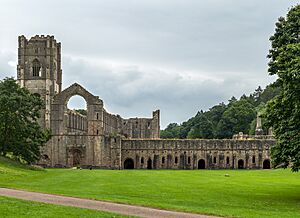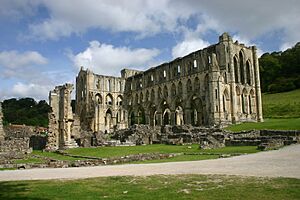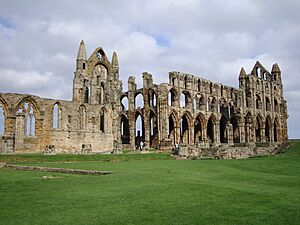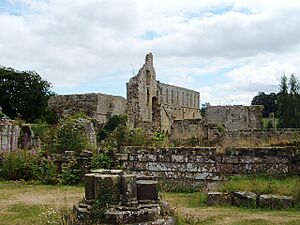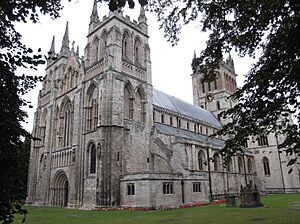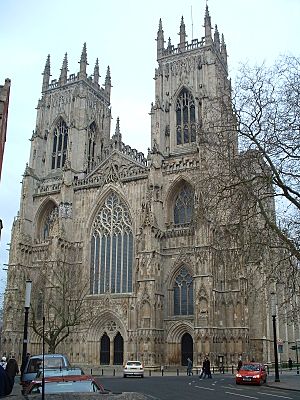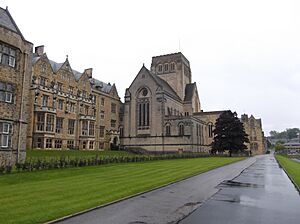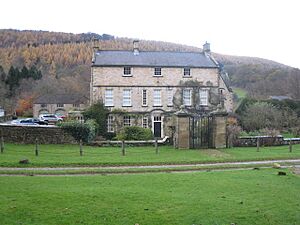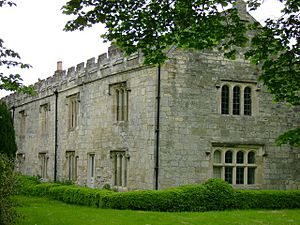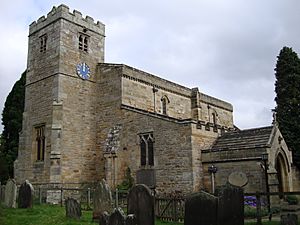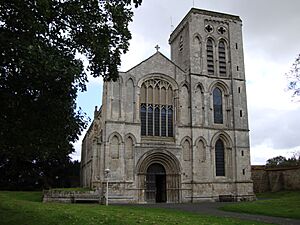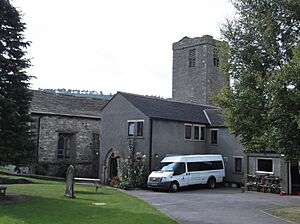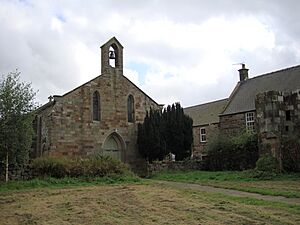List of monastic houses in North Yorkshire facts for kids
North Yorkshire is a historic county in England, known for its beautiful landscapes and rich past. For hundreds of years, it was home to many special communities called monastic houses. These were places where monks or nuns lived, prayed, and worked together, following strict religious rules. They played a huge role in medieval society, acting as centers for learning, farming, and helping the poor.
These houses included large abbeys and smaller priories, as well as places for military orders like the Knights Templar and Knights Hospitaller, and groups of friars who lived among people in towns. Many of these ancient buildings are now ruins, but they still tell amazing stories about life in the past.
Contents
Famous Abbeys and Priories
North Yorkshire was home to many important monastic sites. Here are some of the most well-known ones.
Fountains Abbey
Fountains Abbey was founded in 1132 by a group of Benedictine monks who wanted to live a simpler life. They became Cistercian monks, known for their strict rules and self-sufficient lifestyle. The abbey grew to be one of the largest and wealthiest in England. It was dissolved in 1539 by King Henry VIII. Today, its impressive ruins are a National Trust site, open for visitors to explore.
Rievaulx Abbey
Rievaulx Abbey was another major Cistercian monastery, founded in 1132, the same year as Fountains. It was one of the first Cistercian abbeys in England and became very influential. The monks here were known for their farming and wool production. Like Fountains, it was dissolved in 1538. Its stunning ruins are now managed by English Heritage, offering a glimpse into its past grandeur.
Whitby Abbey
Whitby Abbey has a long and fascinating history, dating back to around 657 AD. It was originally a double monastery, meaning both monks and nuns lived there, led by the famous Saint Hilda. This early monastery was destroyed by Viking raids around 867 AD. It was refounded as a Benedictine monastery in 1078. The dramatic ruins of Whitby Abbey stand on a cliff overlooking the North Sea, inspiring many, including the author Bram Stoker for his novel Dracula. It is now an English Heritage site.
Bolton Priory
Bolton Priory was founded in 1154 for Augustinian Canons Regular. These canons were priests who lived in a community under a religious rule, similar to monks. The priory was first established at Embsay in 1120 before moving to Bolton. It was dissolved in 1540. Today, a part of the original church is still used as the local parish church, making it a living piece of history.
Byland Abbey
Byland Abbey was a Cistercian monastery with a bit of a journey! The community started at Hood in 1138, then moved to Stocking, and finally settled at Byland in 1177. The abbey was dissolved in 1539. Its impressive ruins, including a large rose window, are managed by English Heritage and show how grand these buildings once were.
Jervaulx Abbey
Jervaulx Abbey was another Cistercian monastery, founded in 1156. Its monks were also known for their horse breeding. The abbey was dissolved in 1537. Unlike many other ruins, Jervaulx Abbey is privately owned but is open for visitors to explore its beautiful, overgrown remains.
Mount Grace Priory
Mount Grace Priory is unique because it was home to Carthusian monks. This order was known for its very strict rules, with monks living mostly in silence and solitude in their own small houses within the priory walls. It was founded in 1398 and dissolved in 1537. It is one of the best-preserved Carthusian monasteries in England and is managed by the National Trust.
Selby Abbey
Selby Abbey was founded around 1069-70 by Benedictine monks. It was one of the most important abbeys in the north of England. Unlike many other monastic houses, a large part of Selby Abbey survived the dissolution in 1539 and has been used as a parish church since 1618. It is still a beautiful and active church today.
Ripon Cathedral Priory
Ripon Cathedral Priory has a history stretching back to around 654 AD, when it was founded as a monastery. It went through periods as a Benedictine monastery and a college of secular canons (priests who lived together but didn't follow strict monastic rules). The site was destroyed and rebuilt several times. Today, it is a magnificent cathedral, still a center of worship.
Monastic Houses in York
The city of York was a major religious hub, with many different monastic communities.
York — St Mary's Abbey
York — St Mary's Abbey was a very powerful Benedictine monastery, founded around 1088-89. It was one of the wealthiest abbeys in England. It was dissolved in 1539. Today, its impressive ruins are located in the Museum Gardens in York and are a popular visitor attraction.
York Minster
York Cathedral is not a monastic house in the traditional sense, but it has a long and complex history tied to religious communities. It was founded as a cathedral in 627 AD. Over centuries, it housed different groups of clergy, including monks and secular canons. Today, it is one of the largest and most beautiful Gothic cathedrals in Northern Europe.
Other Notable Monastic Houses
Ampleforth Abbey
Ampleforth Abbey is a Benedictine monastery founded in 1608. Unlike most other houses on this list, it is still active today, with a community of monks and a famous school.
Arden Priory
Arden Priory was a Benedictine priory for nuns, likely founded before 1147. It was dissolved in 1536. Today, a house called 'Arden Hall' stands on the site and even includes some parts of the old priory.
Coverham Abbey
Coverham Abbey was home to Premonstratensian Canons, founded around 1187 at Swainby before moving to Coverham between 1197 and 1202. It was dissolved in 1536. Parts of the abbey's guest-house are now part of a modern house.
Easby Abbey
Easby Abbey was founded in 1152 for Premonstratensian Canons. It was dissolved in 1536-37. The ruins are now managed by the National Trust.
Healaugh Park Priory
Healaugh Park Priory started as a hermitage (a place for a single religious person) before becoming an Augustinian priory in 1218. It was dissolved in 1535. Some of its remains are now part of a farmhouse.
Kirkdale Monastery
Kirkdale Monastery is an ancient Saxon monastic site, possibly founded before 664. It was rebuilt around 1055-1065. The current church of St Gregory stands on this historic spot.
Kirkham Priory
Kirkham Priory was an Augustinian priory founded around 1122. It was dissolved in 1539. Its ruins are now managed by English Heritage.
Lastingham Abbey
Lastingham Abbey was founded by Saint Cedd after 654. It was destroyed by Danish raids around 870. It was refounded as a Benedictine monastery in 1078 but later moved to York. The current church still has parts of the old Saxon monastery.
Malton Priory
Malton Priory was founded around 1150 for Gilbertine Canons, a unique English religious order. It was dissolved in 1539. Part of its church is still used as the Parish Church of St Mary.
Marrick Priory
Marrick Priory was a Benedictine priory for nuns, founded between 1154 and 1158. It was dissolved in 1540. Today, the site is used as an outdoor education and residential center.
Newburgh Priory
Newburgh Priory was an Augustinian priory founded in 1142-43. It was dissolved in 1538. A mansion called 'Newburgh Priory' now stands on the site and is open to the public.
Nun Monkton Priory
Nun Monkton Priory was a Benedictine priory for nuns, founded around 1145. It was dissolved in 1536. Part of its church is still used as a parish church today.
Rosedale Priory
Rosedale Priory was a Cistercian priory for nuns, founded before 1158. It was dissolved in 1535. Some of its remains are now part of houses in the area.
Yedingham Priory
Yedingham Priory was a Benedictine priory for nuns, founded before 1163. It was dissolved in 1539.
Military and Friar Houses
Knights Templar and Hospitaller
These were military religious orders. The Knights Templar were founded to protect pilgrims in the Holy Land, while the Knights Hospitaller cared for sick and poor pilgrims. Both orders had 'preceptories' in North Yorkshire, which were like their local headquarters.
- Copmanthorpe Preceptory (Templar, founded 1258)
- East Cowton Preceptory (Templar, founded around 1142)
- Foulbridge Preceptory (Templar, founded before 1226)
- Mount St John Preceptory (Hospitaller, founded around 1148)
- Penhill Preceptory (Templar, founded around 1155)
- Ribston Preceptory (Templar, founded around 1217, later Hospitaller)
- Temple Hirst Preceptory (Templar, founded 1152)
- Westerdale Preceptory (Templar, founded before 1203, later Hospitaller)
- Whitley Preceptory (Templar, founded before 1248)
Friars in Towns
Friars were different from monks and nuns because they lived and worked among the people in towns, rather than staying in isolated monasteries. They often begged for their living.
- Augustinian Friars (also called Austin Friars): York Austin Friars (founded 1272).
- Dominican Friars (also called Blackfriars because of their black cloaks): York Blackfriars (founded 1227), Scarborough Blackfriars (founded around 1252), Yarm Blackfriars (founded before 1266).
- Franciscan Friars (also called Greyfriars because of their grey robes): York Greyfriars (founded around 1230), Richmond Greyfriars (founded 1257-58), Scarborough Greyfriars (founded 1239).
- Carmelite Friars (also called Whitefriars): Northallerton Whitefriars (founded 1356-57), Scarborough Whitefriars (founded 1319), York Whitefriars, the Stonebow (founded 1253, moved 1295).
- Trinitarians: Knaresborough Priory (founded around 1252).
- Crutched Friars: York Crutched Friars (settled around 1307, but left soon after).
Modern Monastic Houses
While most of these ancient houses are now ruins, some monastic traditions continue in North Yorkshire today.
- Ampleforth Abbey (Benedictine monks) is still active.
- Stanbrook Abbey at Wass is home to Benedictine nuns who moved there in 2007.
- York — St Anne's Monastic House is a Celtic Orthodox church founded in 1995.
Images for kids
See also


